US Dollar Exchange Rates of
10th
Apr
2023
China Yuan 6.88
Report from China
Particleboard production capacity in 2022
According to the Academy of Industry Development and
Planning under the National Forestry and Grassland
Administration (NFGA) and the China Forestry Products
Industry Association (CFPIA) there were 295
particleboard manufacturing enterprises and 314
production lines at the end of 2022 with a production
capacity of 41.48 million cubic metres, up 6% year on
year.
19 production lines began operation nationwide in 2022
adding a production capacity of 5 million cubic metres per
year. The average single-line production capacity further
increased to 132,000 cubic metres per year.
Both the number of enterprises and the number of
production lines in China's particleboard industry have
declined for three consecutive years while the total
production capacity and average single line production
capacity continued to rise.
Shandong Province was the largest in terms of
particleboard production capacity at 9.19 million cubic
metres in 2022, accounting for 22% of the national total.
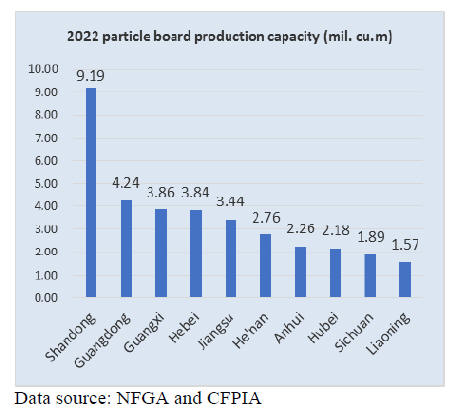
The production capacity in Guangdong, Guangxi, Hebei
and Jiangsu all increased slightly, reaching 4.24 million
cubic metres, 3.86 million cubic metres, 3.84 million cubic
metres and 3.44 million cubic metres annually
respectively.
By the end of 2022 there were 92 continuous flat-pressed
particleboard production lines in China with a total
production capacity of 23.96 million cubic metres per
year, accounting for 58% of the total production capacity
distributed in 18 provinces and regions.
There were 36 large-scale particleboard production
enterprises and groups in China, an increase of 7
enterprises and groups over 2021, with a total production
capacity of 17.46 million cubic metres per year,
accounting for 43% of the total production capacity.
See:
https://www.forestry.gov.cn/main/586/20230227/090603264592795.html
According to China Customs, particleboard imports were
775,000 tonnes valued at US$410 million, up 5% in
volume and 27% in value year on year in 2022.
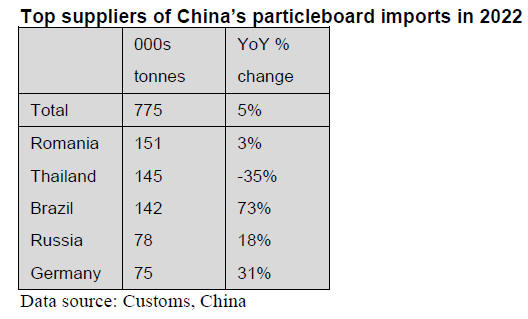
The top suppliers were Romania, Thailand, Brazil,
Russia
and Germany. China’s particleboard imports from
Romania, Brazil, Russia and Germany rose 3%, 73%, 18%
and 31% to 151,000 tonnes, 142,000 tonnes, 78,000 tonnes
and 75,000 tonnes respectively. In contract, China’s
particleboard imports from Thailand fell 35% to 145,000
tonnes in 2022.
Rise in particleboard exports to Japan
According to China Customs, particleboard exports
totalled 370,000 tonnes valued at US$391 million, down
36% in volume and 9% in value year on year in 2022.
Taiwan P.o.C, Mongolia and Japan were the top three
destinations in 2022. Taiwan P.o.C was the largest
destination for China’s particleboard exports, (up 21%
year on year) in 2022. China’s particleboard exports to
Japan surged 480% to 37,000 tonnes valued at US$25
million, up more than 200% year on year in 2022.
Rubberwood imports – prices falling
It is estimated that over the past five years China's imports
of sawn rubberwood and rubberwood products from
Thailand remained stable and accounted for about 3% of
China's total import of goods from Thailand.
According to data from China Customs both the imported
volume and average CIF price of sawn rubberwood from
Thailand showed a decreasing trend from 2017 to 2022.
China imported 3.97 million cubic metres of sawn
rubberwood, with the average CIF price reaching the
lowest at US$250 per cubic metre in 2022. China’s sawn
rubberwood imports fell to 3.97 million cubic metres in
2022 from 4.82 million cubic metres in 2017.
The average CIF price for China’s sawn rubberwood
imports fell to US$250 per cubic metre in 2022 from
US$316 per cubic metre in 2017.
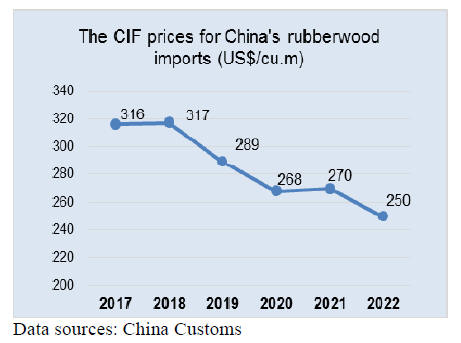
The supply-side reform of China's rubberwood industry
has accelerated since 2018 with the elimination of low-end
production capacity and products, the resilience of the
supply chain increasing and the industry moving to higher
quality development. The import volume of sawn
rubberwood is the largest single category of sawn
hardwood imported from Thailand, accounting for around
40% annually in recent years.
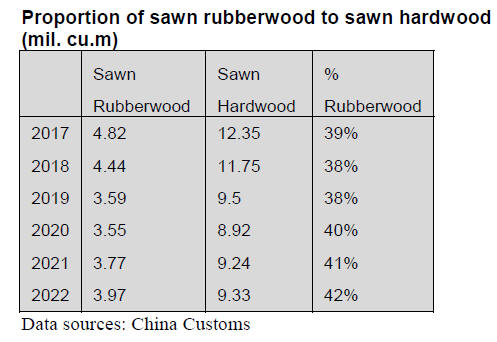
Thai rubberwood is widely used in China. At present the
end products are mainly furniture, wooden doors,
bathroom cabinets, floors, kitchenware, custom homeware.
Now China's home furnishing market is changing to the
direction of personalisation and customisation which
constantly leads the development of rubberwood industry.
New products based on Thai rubberwood emerge in an
endless stream, the supply capacity of high-quality
products is constantly improved and the industrial
structure is further optimised.
2022 sales of flooring in China
According to initial statistics of China National Forest
Product Industry Association (CNFPIA) sales of flooring
products by enterprises with large production in China in
2022 were about 815.6 million square metres, down 11%
year-on-year.
Sales of wood and bamboo flooring were around 354
million square metres, down 14% year on year in 2022. Of
the total, sales of laminate wood flooring amounted to 158
million square metres, a year-on-year decline of 19%.
Sales of solid wood composite flooring were 128 million
square metres, down 13.3%. Solid wood flooring sales of
33 million square metres were down 15% year on year.
Sales of bamboo flooring reached 29.6 million square
metres, a year on year growth of 14%. Sales of wood and
plastic floor amounted to about 73 million square metres,
down 8% year on year. 70% of them were exported of
which 95% were outdoor wood and plastic floor in 2022.
March GGSC report
In March 2023, China's new leadership was elected and a
plan was made for the promotion of Chinese-style
modernisation. The 2023 Government Work Report set
China's GDP growth target at 5% for 2023 and pointed out
that China should encourage the expansion of domestic
demand and create a fair competition and better
development environment for enterprises.
According to data released by the National Bureau of
Statistics, in the first quarter of 2023, China's GDP
reached 9631.1 billion RMB, an increase of 9.7% over the
same period last year.
In March, China's manufacturing PMI index registered
51.9%, demand in the the manufacturing sector continued
to rise, production activities maintained a steady recovery
and shipments were relatively smooth.
In March 2023, with the better macroeconomic trends the
development of China's timber products manufacturing
sector continued to improve. The number of orders and
production of enterprises increased for two consecutive
months, export orders also showed a growth trend, market
trading activities gradually became active and purchasing
volume also increased for two consecutive months.
However, compared with previous years the performance
of timber market demand was still unsatisfactory,
especially the overall export orders have been reduced
compared with previous years.
In March the GTI-China index registered 53.9%, an
increase of 1.5% from the previous month and as above
the critical value (50%) for 2 consecutive months,
indicating that the business prosperity of the timber
enterprises represented by the GTI-China index has
expanded from February.
See:
https://www.ittoggsc.org/static/upload/file/20230414/1681442042214477.pdf
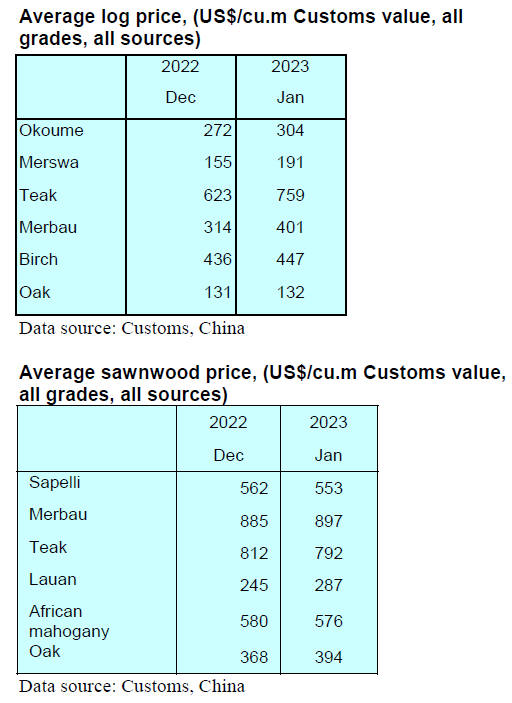

Correction
In the end March report it was stated that China had, over the
past ten years, planted more than 613 million hectares. This was
incorrect it should have read 92 mil. mu or 6.1 mil. ha.
|